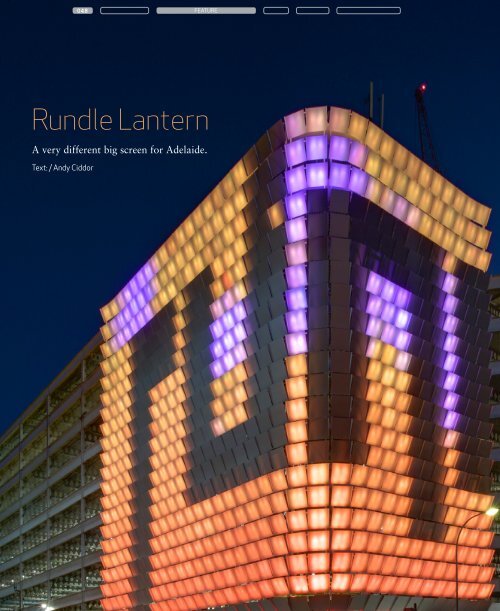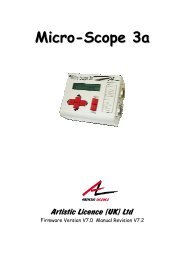Rundle Lantern
Rundle Lantern
Rundle Lantern
You also want an ePaper? Increase the reach of your titles
YUMPU automatically turns print PDFs into web optimized ePapers that Google loves.
048<br />
FEATURE<br />
<strong>Rundle</strong> <strong>Lantern</strong><br />
A very different big screen for Adelaide.<br />
Text: / Andy Ciddor
Let’s be honest, even if you are lucky<br />
enough to live there, Adelaide isn’t the<br />
first city that springs to mind when you<br />
think of innovative town planning and<br />
leading-edge public display systems.<br />
Perhaps because of<br />
this, the Adelaide City<br />
Council was looking<br />
for something bold and<br />
unusual when it ran<br />
a design competition<br />
for projects to enliven<br />
the nightscape at the<br />
eastern end of the<br />
<strong>Rundle</strong> Mall. Much to everyone’s<br />
surprise the winning concept came<br />
from local design consultancy Fusion,<br />
the only non-architectural entrant in<br />
the competition.<br />
The <strong>Rundle</strong> <strong>Lantern</strong> concept<br />
proposed by Fusion’s principal,<br />
Damien Mair, involved wrapping a low<br />
resolution video screen around a rather<br />
unattractive eight-storey council car<br />
park on the corner opposite the <strong>Rundle</strong><br />
Mall. The intention was emphatically<br />
not to display anything as mundane<br />
as football, motor racing, advertising,<br />
news or music videos. According to<br />
Mair: “The vision for the <strong>Lantern</strong> was<br />
to create an experience that would<br />
capture the imagination of the city and<br />
add beauty to people’s lives.” Fusion’s<br />
proposal included the design, provision<br />
and programming of material for the<br />
screen that would include seasonal<br />
and event-related theming and<br />
incorporate creative input from the arts<br />
community.<br />
U Park U Turn<br />
Wrapping any building with over<br />
a 1000sqm of screen presents an<br />
interesting engineering and construction<br />
challenge, but with this building Fusion<br />
had stumbled into some unusual<br />
problems. Intended as a minimum-cost<br />
‘temporary solution’ to CBD parking<br />
needs in the 1960s, the U Park building<br />
was bolted together from oversized<br />
meccano set steel beams to straddle the<br />
existing single-story shops that fronted<br />
on to <strong>Rundle</strong> street.<br />
The vehicle exhaust ventilation system<br />
for the car park followed the common<br />
approach of natural ventilation by<br />
omitting most of the walls. Discussions<br />
with a range of interested parties and<br />
engineering consultants, resulted in the<br />
specification that any screen installed<br />
had to retain 50% of the natural airflow<br />
to avoid the budget-crippling need<br />
for mechanical ventilation. Clearly a<br />
screen that is 50% holes does not make<br />
particularly impressive viewing unless<br />
you can’t see the holes. The solution<br />
was based on the concept of the louvre<br />
windows that were so popular in<br />
Australian homes before we started<br />
using air conditioners.<br />
The final design consisted of 748<br />
anodised aluminium panels, arranged in<br />
22 rows and 34 columns. Each 1.4sqm<br />
panel is carefully angled to provide<br />
visual continuity from street level, yet<br />
retain 50% of the airflow from the<br />
original open-wall design. The images<br />
FEATURE 049<br />
“Wrapping any building with over a<br />
1000sqm of screen presents an interesting<br />
engineering and construction challenge”<br />
are created on the screen by illuminating<br />
each panel from light sources hidden in<br />
the top of the panel below it.<br />
Realising that LEDs were probably<br />
the only type of light source that could<br />
provide the colour<br />
range, longevity and<br />
energy efficiency<br />
required for the screen,<br />
Fusion went looking<br />
around the world for<br />
a company that could<br />
not only provide the<br />
necessary high-output<br />
LEDs, but also the control technology<br />
to drive them as part of a large screen<br />
system.<br />
Space Cannon Broadside<br />
Mair was impressed by the work of<br />
Space Cannon of Italy, particularly<br />
what had been achieved with the<br />
headquarters of the Dexia Group in<br />
Brussels, Belgium, which at the time was<br />
one of the most sophisticated projects<br />
ever attempted. On contacting Space<br />
Cannon to enquire about engaging<br />
their expertise on the project, Mair was<br />
more than a little surprised to find that<br />
the control system and programming<br />
for the Dexia Group headquarters had<br />
actually been done by Melbourne-based<br />
Fabian Barzaghi and Dan Ditmann of<br />
Space Cannon Australia.<br />
The Space Cannon proposal (that was<br />
ultimately implemented on the project),<br />
was to light each of the 714 active<br />
panels with a pair of independently<br />
controlled, custom-built Bisquit LED<br />
luminaries, resulting in a display with<br />
1428 addressable ‘pixels’. The <strong>Rundle</strong><br />
<strong>Lantern</strong> version of the Bisquit are IP66rated<br />
exterior fixtures, containing 12<br />
A sample of the moods and flexibility of the <strong>Rundle</strong> <strong>Lantern</strong>. Images and sequences are composed remotely at the Fusion studio and uploaded to the Green<br />
Hippo controller via a secured broadband link (images courtesy of Fusion).
050<br />
FEATURE<br />
Tiles mounted on the U Park building at angles to allow adequate ventilation of vehicle exhaust fumes.<br />
Images: Andy Ciddor.<br />
high-efficiency LED sources (4 x red, 4 x green<br />
and 4 x blue), configured for full-spectrum<br />
RGB colour mixing via the DMX512A control<br />
protocol, and remotely addressable via the<br />
Remote Device Management (RDM) protocol.<br />
The Space Cannon package also included the<br />
design, commissioning and programming<br />
of a suitable data distribution, control and<br />
programming system.<br />
Although the <strong>Rundle</strong> <strong>Lantern</strong> is low<br />
resolution compared to even a standard<br />
definition TV, it still requires a rather<br />
substantial 4284 channels of lighting DMX512<br />
control to operate it. Feeding DMX data and<br />
allocating DMX addresses to 1428 fixtures is<br />
not a trivial problem. The DMX network limit<br />
of 32 devices connected in any one daisychain<br />
necessitated an eight-way optically-isolated<br />
splitter for each of the nine DMX universes.<br />
Transport for the nine DMX streams was via<br />
Ethernet using ArtNet, the public domain<br />
DMX-over-Ethernet protocol developed by<br />
Artistc Licence in the UK.<br />
Rather than attempt the nightmare task of<br />
allocating a DMX address via DIP switches<br />
on each fixture at the point where they were<br />
either unpacked or fixed to the display panels,<br />
Barzaghi and Ditmann had specified that the<br />
luminaires should be capable of communicating<br />
via the recently ratified Remote Device<br />
Management extension to the DMX512<br />
protocol. The RDM software deployed in the<br />
Bisquit luminaires was developed for Space<br />
Cannon by Australian RDM pioneers Enttec.<br />
Using a standard notebook computer fitted<br />
with an Enttec RDM interface and controller<br />
software, Barzaghi and Ditmann were able to<br />
identify and interrogate each fixture once it<br />
was in place and assign its allocated address<br />
without touching the luminaire, a process<br />
that saved many dozens of hours of fiddling,<br />
double handling and construction time.<br />
Seeing the Light<br />
Images for the <strong>Lantern</strong> are displayed using<br />
a Green Hippo Hippotizer V3 Stage media<br />
server that takes a video feed and translates it<br />
on-the-fly into the appropriate ArtNet control<br />
signals to drive the LEDs in each Space<br />
Cannon ‘pixel’. The Hippotizer is located<br />
(together with its outside communications<br />
links) in the bottom of the U Park building.<br />
Keeping the Hippotizer company in that rack<br />
is an Enttec E-Streamer replay system which,<br />
because it has both an astronomical clock and<br />
ArtNet output, has been allocated the menial<br />
task of powering the LED fixtures up and<br />
down for each night’s presentation.<br />
Several floors above the Hippotizer,<br />
perched in a corner of the carpark near the<br />
midpoint of the screen, is the control rack<br />
packed with Enttec DataGate, EtherGate, and<br />
ODE ArtNet-to-DMX converters, a pile of<br />
Tech Art DMX splitters, power distribution<br />
modules, a relay rack and a large collection<br />
TechArt DMX patch panels.<br />
Content creation and management for<br />
the <strong>Lantern</strong> is supplied as part of an ongoing<br />
contract by the design team at Fusion, using<br />
Green Hippo’s Pixel Mapper software and the<br />
Zoo Keeper remote management software,<br />
from their facility in central Adelaide.<br />
Although starting out as a project that would<br />
probably call on a range of outside consultants<br />
and overseas companies, the majority of this<br />
landmark development was put together by a<br />
team of world-class locals. �<br />
See some of the <strong>Rundle</strong> <strong>Lantern</strong> programming live<br />
on webcam (it updates every five seconds) at<br />
www.cityofadelaide.com.au/rundlelantern<br />
Andy Ciddor attended the opening of the <strong>Rundle</strong><br />
<strong>Lantern</strong> as a guest of Space Cannon Australia.<br />
Space Cannon Bisquit fixtures with diffusion on near side<br />
for even illumination of the tiles.<br />
Equipment list<br />
1428 x Space Cannon Bisquit custom 12 LED RDM<br />
9 x TecArt Splitter 8 way opto isolated<br />
9 x TecArt 8 way patch panels<br />
1 x TecArt 12 channel relay rack<br />
1 x Enttec E-Streamer<br />
1 x Enttec Datagate DE<br />
1 x Enttec Ethergate<br />
1 x Enttec ODE<br />
1 x Green Hippo Hippotizer V3 Stage<br />
with Pixelmapper software and Zoo Keeper<br />
1 x Netgear Gigabit switch<br />
Sightlines were calculated for each tile to provide sufficient<br />
visual overlap and optimum ventilation.<br />
(Images courtesy of Fusion)



